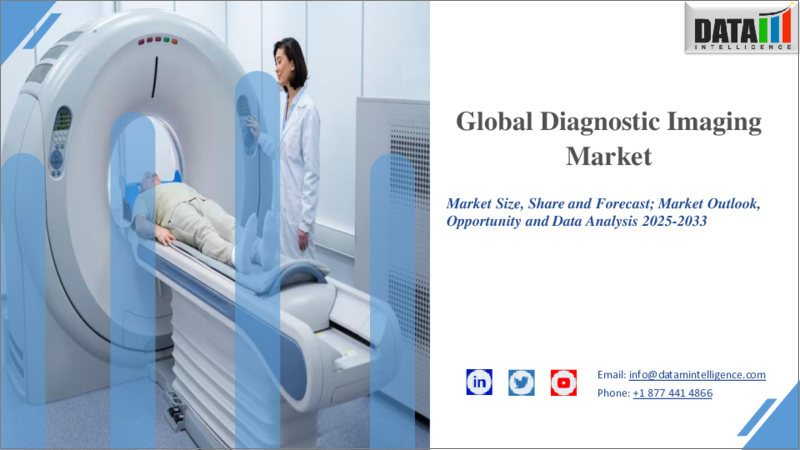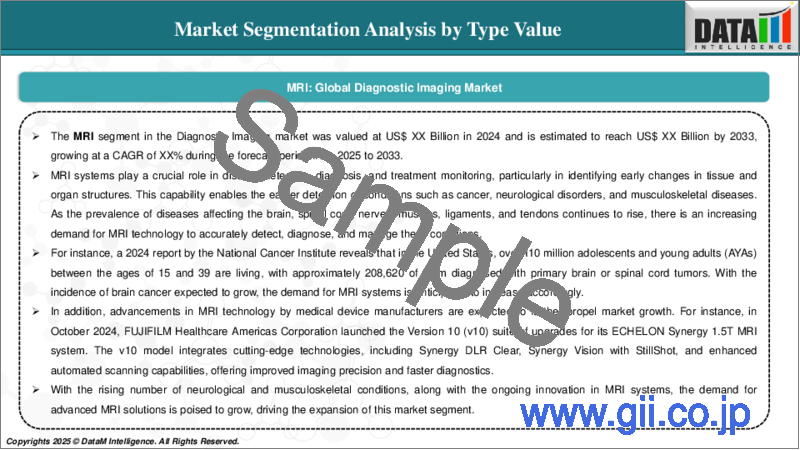|
|
市場調査レポート
商品コード
1702348
画像診断の世界市場:2025年~2033年Global Diagnostic Imaging Market - 2025-2033 |
||||||
カスタマイズ可能
適宜更新あり
|
|||||||
| 画像診断の世界市場:2025年~2033年 |
|
出版日: 2025年04月10日
発行: DataM Intelligence
ページ情報: 英文 180 Pages
納期: 即日から翌営業日
|
- 全表示
- 概要
- 目次
世界の画像診断の市場規模は、2024年に299億3,000万米ドルに達し、2033年には462億5,000万米ドルに達すると予測され、2025年から2033年の予測期間中にCAGR 4.9%で成長する見込みです。
画像診断には、医療従事者が様々な症状を診断、監視、治療できるように、体内を視覚的に表現するために使用される様々な医療技術が含まれます。X線、CTスキャン、MRI、超音波検査、核医学検査などを含むこれらの画像診断法は、詳細な画像を提供し、医師が痛みや腫れ、健康診断での異常所見などの症状の根本原因を特定するのに役立ちます。
診断にとどまらず、画像診断は骨折、腫瘍、感染症、慢性疾患などの治療経過を観察する上でも重要な役割を果たしています。非侵襲的に体内構造を検査できる画像診断は、正確でタイムリーな医療介入と継続的な患者ケアに不可欠です。
慢性疾患や病的状態の蔓延により、高度な画像診断技術に対する大きな需要が生じています。合併症の早期発見の必要性が高まるにつれ、画像診断機器市場は急速に拡大しています。X線撮影、超音波検査、透視検査、核医学検査などの技術を利用したこれらの画像診断法は、体内の詳細な画像を提供し、さまざまな慢性疾患の診断に不可欠です。これらの方法で診断される最も一般的な疾患は、心血管疾患、がん、慢性呼吸器疾患、糖尿病などです。
例えば、全米骨粗鬆症財団によると、米国では1,020万人が骨粗鬆症に罹患しており、女性の方が男性(5.1%)より有病率が高くなっています(16.5%)。さらに、4,340万人が骨量が少ないです。2030年には、7,100万人の成人が骨粗鬆症または骨量の少ない状態になると予測されています。同様に、アメリカがん協会の2024年世界がん統計報告書では、2022年に世界で約2,000万人が新たにがんと診断され、970万人が死亡したと強調されています。2050年には、世界のがん患者数は3,500万人に増加すると予想されています。このような慢性疾患が増え続ける中、画像診断の需要は伸び続け、市場の拡大を牽引しています。
画像診断システムに関連する高コストは、画像診断市場の成長に大きな課題をもたらすと予想されます。MRI装置、CTスキャナ、PETスキャナなどの先端技術には、購入や設置のための多額の先行投資と、保守・運用のための継続的な費用が必要です。
多くのヘルスケア施設にとって、このような高度なシステムの取得と維持にかかる経済的負担は法外なものです。その結果、画像診断システムに関連する高額なコストは、特にヘルスケア予算が既に逼迫している地域において、市場の成長を鈍化させる可能性が高いです。
当レポートでは、世界の画像診断市場について調査し、市場の概要とともに、タイプ別、用途別、エンドユーザー別、地域別動向、競合情勢、および市場に参入する企業のプロファイルなどを提供しています。
目次
第1章 市場のイントロダクションと範囲
第2章 経営者の洞察と重要なポイント
第3章 市場力学
- 影響要因
- 促進要因
- 抑制要因
- 機会
- 影響分析
第4章 戦略的洞察と業界展望
- 市場のリーダーとパイオニア
- CXOの視点
- 最新の開発とブレークスルー
- ケーススタディ/進行中の調査
- 規制と償還の情勢
- ポーターのファイブフォース分析
- サプライチェーン分析
- 特許分析
- SWOT分析
- アンメットニーズとギャップ
- 市場参入と拡大のための推奨戦略
- シナリオ分析ベストケース、ベースケース、ワーストケースの予測
- 価格分析と価格動向
- キーオピニオンリーダー
第5章 画像診断市場(タイプ別)
- MRI
- X線
- 核医学
- 超音波
- 断層撮影
- 触覚イメージング
- 機能的近赤外分光法
第6章 画像診断市場(用途別)
- 整形外科
- 神経科
- 腫瘍科
- その他
第7章 画像診断市場(エンドユーザー別)
- 画像診断センター
- 病院
- その他
第8章 画像診断市場、市場分析と成長機会、地域別
- 北米
- 米国
- カナダ
- 欧州
- ドイツ
- 英国
- フランス
- スペイン
- イタリア
- その他
- ラテンアメリカ
- メキシコ
- ブラジル
- アルゼンチン
- その他
- アジア太平洋
- 中国
- インド
- 日本
- 韓国
- その他
- 中東・アフリカ
第9章 競合情勢と市場ポジショニング
第10章 企業プロファイル
- GE HealthCare
- 会社概要
- 製品ポートフォリオ
- 財務概要
- 主な発展
- SWOT分析
- Siemens Healthineers AG
- Carestream Health
- Hitachi Medical Corporation
- Canon Medical Systems Corporation
- Hologic, Inc.
- Koninklijke Philips NV
- Fujifilm Holdings Corporation
- Shimadzu Corporation
- Mindray
第11章 仮定と調査手法
第12章 付録
The global diagnostic imaging market reached US$ 29.93 billion in 2024 and is expected to reach US$ 46.25 billion by 2033, growing at a CAGR of 4.9% during the forecast period of 2025-2033.
Diagnostic imaging encompasses a variety of medical techniques used to create visual representations of the interior of the body, enabling healthcare professionals to diagnose, monitor, and treat various conditions. These imaging methods, which include X-rays, CT scans, MRIs, ultrasounds, and nuclear medicine, provide detailed images that help doctors identify the underlying causes of symptoms, such as pain, swelling, or unusual findings in physical exams.
Beyond diagnosis, diagnostic imaging also plays a key role in monitoring the progress of treatments for conditions like fractures, tumors, infections, or chronic diseases. By offering a non-invasive way to examine the body's internal structures, diagnostic imaging is essential for accurate, timely medical intervention and ongoing patient care.
Market Dynamics: Drivers & Restraints
Increasing Incidence of Chronic Diseases
The growing prevalence of chronic and pathological conditions has created a significant demand for advanced diagnostic imaging technologies. As the need for early detection of complications increases, the market for diagnostic imaging equipment has expanded rapidly. These imaging procedures, which utilize techniques such as radiography, ultrasonography, fluoroscopy, and nuclear medicine, provide detailed internal visuals of the body and are essential for diagnosing a variety of chronic disorders. Among the most common conditions diagnosed through these methods are cardiovascular disease, cancer, chronic respiratory disorders, and diabetes.
For example, according to the National Osteoporosis Foundation, 10.2 million people in the U.S. are affected by osteoporosis, with women experiencing a higher prevalence (16.5%) than men (5.1%). Additionally, 43.4 million people have low bone mass. It's projected that by 2030, 71 million adults will have osteoporosis or poor bone mass. Similarly, the American Cancer Society's 2024 Global Cancer Statistics report highlighted that approximately 20 million new cancer cases were diagnosed worldwide in 2022, with 9.7 million deaths attributed to the disease. By 2050, the global number of cancer cases is expected to rise to 35 million. As these chronic diseases continue to increase, the demand for diagnostic imaging continues to grow, driving the expansion of the market.
High Costs of Diagnostic Imaging Systems
The high costs associated with diagnostic imaging systems are expected to pose a significant challenge to the growth of the diagnostic imaging market. These advanced technologies, such as MRI machines, CT scanners, and PET scanners, require substantial upfront investment for purchasing and installation, as well as ongoing expenses for maintenance and operation.
For many healthcare facilities, the financial burden of acquiring and maintaining these sophisticated systems can be prohibitive. As a result, the high costs associated with diagnostic imaging systems are likely to slow down the market's growth, especially in regions where healthcare budgets are already stretched.
Segment Analysis
The global diagnostic imaging market is segmented based on type, application, end-user, and region.
MRI in the type segment is expected to dominate the diagnostic imaging market
The MRI segment is expected to hold a significant portion of the market share. This is because of their ability to produce detailed images of organs, as well as technological advances in product innovation. Magnetic resonance imaging (MRI) is a diagnostic tool that can generate detailed images of almost any structure or organ in the body.
MRI produces images on a computer using magnets and radio waves. The images produced by an MRI scan can include organs, bones, muscles, and blood arteries. Hospitals and diagnostic centers often prefer advanced, emerging, and innovative MRI solutions to diagnose diseases in the body, which is creating a demand for MRI systems.
MRI systems play a crucial role in disease detection, diagnosis, and treatment monitoring, particularly in identifying early changes in tissue and organ structures. This capability enables the earlier detection of conditions such as cancer, neurological disorders, and musculoskeletal diseases. As the prevalence of diseases affecting the brain, spinal cord, nerves, muscles, ligaments, and tendons continues to rise, there is an increasing demand for MRI technology to accurately detect, diagnose, and manage these conditions.
For instance, a 2024 report by the National Cancer Institute reveals that in the United States, over 110 million adolescents and young adults (AYAs) between the ages of 15 and 39 are living, with approximately 208,620 of them diagnosed with primary brain or spinal cord tumors. With the incidence of brain cancer expected to grow, the demand for MRI systems is anticipated to increase accordingly.
In addition, advancements in MRI technology by medical device manufacturers are expected to further propel market growth. For instance, in October 2024, FUJIFILM Healthcare Americas Corporation launched the Version 10 (v10) suite of upgrades for its ECHELON Synergy 1.5T MRI system. The v10 model integrates cutting-edge technologies, including Synergy DLR Clear, Synergy Vision with StillShot, and enhanced automated scanning capabilities, offering improved imaging precision and faster diagnostics.
With the rising number of neurological and musculoskeletal conditions, along with the ongoing innovation in MRI systems, the demand for advanced MRI solutions is poised to grow, driving the expansion of this market segment.
Geographical Analysis
North America is expected to dominate the diagnostic imaging market
The diagnostic imaging market in North America is driven by the increasing incidence of chronic diseases, the innovation of advanced systems, and also due to the presence of a large number of market players. The increasing applications of diagnostic imaging for various purposes and the presence of reimbursements in the region are expected to contribute to the region's market growth.
Moreover, North America adopts advanced technologies and systems in the healthcare industry, which could create a lucrative opportunity for the region's diagnostic imaging market growth. Cancer, cardiovascular disease, and osteoarthritis are rising among elderly individuals, raising the need and utilization of different diagnostics such as X-rays, MRIs, and CT scans. For instance, according to a report published by the Centers for Disease Control and Prevention in 2024, Heart abnormalities impact around 40,000 babies annually in the United States.
Similarly, according to the CDC revised report in 2024, approximately 53.2 million persons in the US suffer from arthritis. There are over 100 forms of arthritis, but osteoarthritis is the most common, affecting 32.5 million US people. With the rising abnormalities, the demand for diagnostic imaging rises. This transition has increased market demand for diagnostic imaging services. Healthcare providers are constantly investing in improved imaging technology to cater to this growing generation, fueling market development.
Market players in the region are increasingly innovating advanced diagnostic imaging solutions, which are expected to contribute to the region's market share. Several organizations, hospitals, and healthcare institutes are conducting mobile health services in the region, which is expected to increase the adoption of advanced diagnostic imaging systems, which could contribute to the market growth.
For instance, in August 2024, DocGo Inc. launched an innovative mobile X-ray program in partnership with MinXray. The program launched in New York City to provide rapid and accessible chest X-rays for vulnerable populations and help identify active Tuberculosis ("TB") cases. These programs increase the usage of the systems. Thus, the above factors are expected to hold the region in a significant position in the market share.
Competitive Landscape
The global market players in the diagnostic imaging market are GE HealthCare, Siemens Healthineers AG, Carestream Health, Hitachi Medical Corporation, Canon Medical Systems Corporation, Hologic, Inc., Koninklijke Philips N.V., Fujifilm Holdings Corporation, Shimadzu Corporation, and Mindray, among others.
Why Purchase the Report?
- Pipeline & Innovations: Reviews ongoing clinical trials and product pipelines and forecasts upcoming pharmaceutical advancements.
- Type Performance & Market Positioning: Analyze product performance, market positioning, and growth potential to optimize strategies.
- Real-World Evidence: Integrates patient feedback and data into product development for improved outcomes.
- Physician Preferences & Health System Impact: Examines healthcare provider behaviors and the impact of health system mergers on adoption strategies.
- Market Updates & Industry Changes: This covers recent regulatory changes, new policies, and emerging technologies.
- Competitive Strategies: Analyze competitor strategies, market share, and emerging players.
- Pricing & Market Access: Reviews pricing models, reimbursement trends, and market access strategies.
- Market Entry & Expansion: Identifies optimal strategies for entering new markets and partnerships.
- Regional Growth & Investment: Highlights high-growth regions and investment opportunities.
- Supply Chain Optimization: Assesses supply chain risks and distribution strategies for efficient Type delivery.
- Sustainability & Regulatory Impact: Focuses on eco-friendly practices and evolving regulations in healthcare.
- Post-market Surveillance: Uses post-market data to enhance product safety and access.
- Pharmacoeconomics & Value-Based Pricing: Analyzes the shift to value-based pricing and data-driven decision-making in R&D.
The global diagnostic imaging market report would provide approximately 45 tables, 46 figures, and 180 pages.
Target Audience 2024
- Manufacturers: Pharmaceutical, Biotech Companies, Contract Manufacturers, Distributors, Hospitals.
- Regulatory & Policy: Compliance Officers, Government, Health Economists, Market Access Specialists.
- Technology & Innovation: R&D Professionals, Clinical Trial Managers, Pharmacovigilance Experts.
- Investors: Healthcare Investors, Venture Fund Investors, Pharma Marketing & Sales.
- Consulting & Advisory: Healthcare Consultants, Industry Associations, Analysts.
- Supply Chain: Distribution and Supply Chain Managers.
- Consumers & Advocacy: Patients, Advocacy Groups, Insurance Companies.
- Academic & Research: Academic Institutions.
Table of Contents
1. Market Introduction and Scope
- 1.1. Objectives of the Report
- 1.2. Report Coverage & Definitions
- 1.3. Report Scope
2. Executive Insights and Key Takeaways
- 2.1. Market Highlights and Strategic Takeaways
- 2.2. Key Trends and Future Projections
- 2.3. Snippet by Type
- 2.4. Snippet by Application
- 2.5. Snippet by End-User
- 2.6. Snippet by Region
3. Dynamics
- 3.1. Impacting Factors
- 3.1.1. Drivers
- 3.1.1.1. Increasing Incidence of Chronic Diseases
- 3.1.1.2. Rising Innovation of Advanced Products
- 3.1.2. Restraints
- 3.1.2.1. High Costs of the Diagnostic Imaging Systems
- 3.1.2.2. Lack of Skilled Professionals
- 3.1.3. Opportunity
- 3.1.3.1. Technological Advancements
- 3.1.4. Impact Analysis
- 3.1.1. Drivers
4. Strategic Insights and Industry Outlook
- 4.1. Market Leaders and Pioneers
- 4.1.1. Emerging Pioneers and Prominent Players
- 4.1.2. Established leaders with largest selling Brand
- 4.1.3. Market leaders with established Product
- 4.2. CXO Perspectives
- 4.3. Latest Developments and Breakthroughs
- 4.4. Case Studies/Ongoing Research
- 4.5. Regulatory and Reimbursement Landscape
- 4.5.1. North America
- 4.5.2. Europe
- 4.5.3. Asia Pacific
- 4.5.4. Latin America
- 4.5.5. Middle East & Africa
- 4.6. Porter's Five Forces Analysis
- 4.7. Supply Chain Analysis
- 4.8. Patent Analysis
- 4.9. SWOT Analysis
- 4.10. Unmet Needs and Gaps
- 4.11. Recommended Strategies for Market Entry and Expansion
- 4.12. Scenario Analysis: Best-Case, Base-Case, and Worst-Case Forecasts
- 4.13. Pricing Analysis and Price Dynamics
- 4.14. Key Opinion Leaders
5. Diagnostic Imaging Market, By Type
- 5.1. Introduction
- 5.1.1. Market Size Analysis and Y-o-Y Growth Analysis (%), By Type
- 5.1.2. Market Attractiveness Index, By Type
- 5.2. MRI*
- 5.2.1. Introduction
- 5.2.2. Market Size Analysis and Y-o-Y Growth Analysis (%)
- 5.2.3. Low-Field MRI Scanners
- 5.2.4. High-Field MRI Scanners
- 5.2.5. Mid-Field MRI Scanners
- 5.3. X-Ray
- 5.3.1. Analog Imaging
- 5.3.2. Digital Imaging
- 5.4. Nuclear Medicine
- 5.4.1. Scintigraphy
- 5.4.2. PET Imaging
- 5.4.3. SPECT Imaging
- 5.5. Ultrasound
- 5.5.1. 2D Ultrasound
- 5.5.2. 3D/4D Ultrasound
- 5.5.3. Doppler Imaging
- 5.6. Tomography
- 5.6.1. High-End Slice CT Scanners
- 5.6.2. Mid-End Slice CT Scanners
- 5.6.3. Low-End Slice CT Scanners
- 5.7. Tactile Imaging
- 5.8. Functional Near Infrared Spectroscopy
6. Diagnostic Imaging Market, By Application
- 6.1. Introduction
- 6.1.1. Market Size Analysis and Y-o-Y Growth Analysis (%), By Application
- 6.1.2. Market Attractiveness Index, By Application
- 6.2. Orthopedic*
- 6.2.1. Introduction
- 6.2.2. Market Size Analysis and Y-o-Y Growth Analysis (%)
- 6.2.3. Arthritis
- 6.2.4. Fractures and Dislocations
- 6.2.5. Osteoporosis
- 6.2.6. Spine Orthopedics
- 6.2.7. Others
- 6.3. Neurology
- 6.3.1. Brain Tumors
- 6.3.2. Traumatic Brain Injury
- 6.3.3. Brain Stroke
- 6.3.4. Others
- 6.4. Oncology
- 6.4.1. Breast Cancer
- 6.4.2. Colorectal Cancer
- 6.4.3. Lung Cancer
- 6.4.4. Other Cancers
- 6.5. Others
7. Diagnostic Imaging Market, By End User
- 7.1. Introduction
- 7.1.1. Market Size Analysis and Y-o-Y Growth Analysis (%), By End User
- 7.1.2. Market Attractiveness Index, By End User
- 7.2. Diagnostic Imaging Centers*
- 7.2.1. Introduction
- 7.2.2. Market Size Analysis and Y-o-Y Growth Analysis (%)
- 7.3. Hospitals
- 7.4. Others
8. Diagnostic Imaging Market, By Regional Market Analysis and Growth Opportunities
- 8.1. Introduction
- 8.1.1. Market Size Analysis and Y-o-Y Growth Analysis (%), By Region
- 8.1.2. Market Attractiveness Index, By Region
- 8.2. North America
- 8.2.1. Introduction
- 8.2.2. Key Region-Specific Dynamics
- 8.2.3. Market Size Analysis and Y-o-Y Growth Analysis (%), By Type
- 8.2.4. Market Size Analysis and Y-o-Y Growth Analysis (%), By Application
- 8.2.5. Market Size Analysis and Y-o-Y Growth Analysis (%), By End User
- 8.2.6. Market Size Analysis and Y-o-Y Growth Analysis (%), By Country
- 8.2.6.1. U.S.
- 8.2.6.2. Canada
- 8.3. Europe
- 8.3.1. Introduction
- 8.3.2. Key Region-Specific Dynamics
- 8.3.3. Market Size Analysis and Y-o-Y Growth Analysis (%), By Type
- 8.3.4. Market Size Analysis and Y-o-Y Growth Analysis (%), By Application
- 8.3.5. Market Size Analysis and Y-o-Y Growth Analysis (%), By End User
- 8.3.6. Market Size Analysis and Y-o-Y Growth Analysis (%), By Country
- 8.3.6.1. Germany
- 8.3.6.2. U.K.
- 8.3.6.3. France
- 8.3.6.4. Spain
- 8.3.6.5. Italy
- 8.3.6.6. Rest of Europe
- 8.4. Latin America
- 8.4.1. Introduction
- 8.4.2. Key Region-Specific Dynamics
- 8.4.3. Market Size Analysis and Y-o-Y Growth Analysis (%), By Type
- 8.4.4. Market Size Analysis and Y-o-Y Growth Analysis (%), By Application
- 8.4.5. Market Size Analysis and Y-o-Y Growth Analysis (%), By End User
- 8.4.6. Market Size Analysis and Y-o-Y Growth Analysis (%), By Country
- 8.4.6.1. Mexico
- 8.4.6.2. Brazil
- 8.4.6.3. Argentina
- 8.4.6.4. Rest of Latin America
- 8.5. Asia-Pacific
- 8.5.1. Introduction
- 8.5.2. Key Region-Specific Dynamics
- 8.5.3. Market Size Analysis and Y-o-Y Growth Analysis (%), By Type
- 8.5.4. Market Size Analysis and Y-o-Y Growth Analysis (%), By Application
- 8.5.5. Market Size Analysis and Y-o-Y Growth Analysis (%), By End User
- 8.5.6. Market Size Analysis and Y-o-Y Growth Analysis (%), By Country
- 8.5.6.1. China
- 8.5.6.2. India
- 8.5.6.3. Japan
- 8.5.6.4. South Korea
- 8.5.6.5. Rest of Asia-Pacific
- 8.6. Middle East and Africa
- 8.6.1. Introduction
- 8.6.2. Key Region-Specific Dynamics
- 8.6.3. Market Size Analysis and Y-o-Y Growth Analysis (%), By Type
- 8.6.4. Market Size Analysis and Y-o-Y Growth Analysis (%), By Application
- 8.6.5. Market Size Analysis and Y-o-Y Growth Analysis (%), By End User
9. Competitive Landscape and Market Positioning
- 9.1. Competitive Overview and Key Market Players
- 9.2. Market Share Analysis and Positioning Matrix
- 9.3. Strategic Partnerships, Mergers & Acquisitions
- 9.4. Key Developments in Product Portfolios and Innovations
- 9.5. Company Benchmarking
10. Company Profiles
- 10.1. GE HealthCare*
- 10.1.1. Company Overview
- 10.1.2. Product Portfolio
- 10.1.2.1. Product Description
- 10.1.2.2. Product Key Performance Indicators (KPIs)
- 10.1.2.3. Historic and Forecasted Product Sales
- 10.1.2.4. Product Sales Volume
- 10.1.3. Financial Overview
- 10.1.3.1. Company Revenue's
- 10.1.3.2. Geographical Revenue Shares
- 10.1.3.3. Revenue Forecasts
- 10.1.4. Key Developments
- 10.1.4.1. Mergers & Acquisitions
- 10.1.4.2. Key Product Development Activities
- 10.1.4.3. Regulatory Approvals, etc.
- 10.1.5. SWOT Analysis
- 10.2. Siemens Healthineers AG
- 10.3. Carestream Health
- 10.4. Hitachi Medical Corporation
- 10.5. Canon Medical Systems Corporation
- 10.6. Hologic, Inc.
- 10.7. Koninklijke Philips N.V.
- 10.8. Fujifilm Holdings Corporation
- 10.9. Shimadzu Corporation
- 10.10. Mindray
LIST NOT EXHAUSTIVE
11. Assumption and Research Methodology
- 11.1. Data Collection Methods
- 11.2. Data Triangulation
- 11.3. Forecasting Techniques
- 11.4. Data Verification and Validation
12. Appendix
- 12.1. About Us and Services
- 12.2. Contact Us






